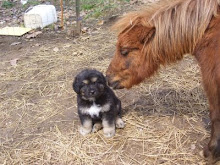Tonight, I spent most of the evening starting my cold weather seeds. Lots of different kinds of veggie and herb seeds. I choose to start most of all my plants indoors. There are a couple of reasons for this. F
 irst of all, it gives me a head start on the season. Additionally, it lets me have more control over their growing conditions. Before I go to plant them out in my raised beds, I'll know exactly what I have. This is important to me because I have limited space in my garden. By starting my seeds indoors, I can space them in my garden exactly how I want, I don't have to thin out plants and I don't have to worry about poor germination because I'll know that I all ready have a plant to put there. There are some seeds that don't do well being transplanted and are best suited directly planted in the garden. Some are obvious, such as root vegetables like carrots or radish. Some are less obvious, such as cilantro and corn. For the most part though, I put most of my plants into my garden as transplants.
irst of all, it gives me a head start on the season. Additionally, it lets me have more control over their growing conditions. Before I go to plant them out in my raised beds, I'll know exactly what I have. This is important to me because I have limited space in my garden. By starting my seeds indoors, I can space them in my garden exactly how I want, I don't have to thin out plants and I don't have to worry about poor germination because I'll know that I all ready have a plant to put there. There are some seeds that don't do well being transplanted and are best suited directly planted in the garden. Some are obvious, such as root vegetables like carrots or radish. Some are less obvious, such as cilantro and corn. For the most part though, I put most of my plants into my garden as transplants.Starting seeds inside is easy and doesn't require much special equipment. You can start your plants out in a lot of different containers. Personally, I use the seed trays that you can buy at a seed store. But butter tubs, yogurt containers, egg cartons even Dixie cups will work equally as well. Just make sure you have drainage holes in the bottom (and make sure you have this set in something to catch the drainage water.) Fill the container with a seed starting medium. I always buy this, you want it to be sterile and you don't want it to contain any fertilizer, organic or not. Seeds have all the nutrients it needs to get started, it can actually be detrimental for the plant to get too much food right after it sprouts. After they get their first set of true leaves, we will transplant these starts into larger containers, then we will give them some food.
After you've filled up the container with starter medium, place the seed in the medium. The seed package should tell you how deep to put the seed in. A good rule of th
 umb is the smaller seed the closer to the surface it should be planted, conversely the larger the seed the deeper it will go. A few seeds need sunlight to germinate, the package should tell you this. Make sure you label your seeds, I use whatever I have handy. Popsicle sticks make a cheap marker.
umb is the smaller seed the closer to the surface it should be planted, conversely the larger the seed the deeper it will go. A few seeds need sunlight to germinate, the package should tell you this. Make sure you label your seeds, I use whatever I have handy. Popsicle sticks make a cheap marker.Now, you need to water the seeds. I always water my seeds from the bottom. Because I sell my extra plants, I need to make sure they are the correct plants, if I were to water from above, the medium could float into another tray. Also, once the seeds start to sprout, watering from above could facilitate a condition called damping off. So, I pour the water right into the drainage tray. The medium will soak the water up to the surface. Watch your containers for a couple of hours, adding water periodically until the surface of the containers show it's become damp.
It will take several days for your seeds to start to poke out of the soil, depending on the plant. Plants like lettuce should germinate in about 5 days, some like lavender germinate sporadically and could take up to two weeks. Be patient, during this waiting time, make sure the starter medium does not dry out. Find a happy balance, though, you don't want the seeds to be swimming in water either.
***I forgot to mention light. It is not necessary to have your seedlings in light to get them started. However, as soon as they start to sprout, put them in the sunniest location you can find. By a window or under grow lights will work, I've even taken my plants out in the morning and in again at night so get them in the sunlight.
Some of these plants, we will put outside soon after they get their true leaves (these will actually seem to you to be their second set of leaves, called the true leaves), such as the lettuce. Others we will transplant into larger containers and give them special treatment for a few more weeks in the house, such as tomato or eggplant.
Stay tuned, we are going to talk about how to plant in a cold frame and in a couple of posts, how to build a cold frame. They are easy and really useful for getting a jump start on the season.

No comments:
Post a Comment